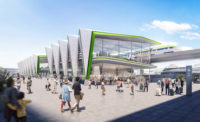Buoyed by the arrival of a more transit-friendly administration in Washington, high-speed rail proponents aim to take advantage of the current emphasis on infrastructure and garner more federal support for deployment of these systems across the country.
Speaking at an online discussion organized by the United for Infrastructure advocacy group, American Public Transportation Association President and CEO Paul Skoutelas called the current intense focus on infrastructure “a once-in-a generation opportunity” to establish long-term support for all modes of public transit, including intercity high-speed rail.
But rather than relying solely on one-time infusions of cash bundled with other transportation needs, Skoutelas called for establishment of a long-term funding source similar to the Highway Trust Fund.
Likening deployment of intercity high-speed rail to the multi-decade construction of the interstate highway system, Skoutelas said the reliability of a dedicated revenue stream “is the only way to make sure the vision for building out a true intercity high-speed rail network will come to fruition.”
Reduced reliance on public subsidies in favor of private investment would likewise benefit high-speed rail deployment, observed Husein Cumber, chief strategy officer for Florida East Coast Industries, which is expanding its Brightline passenger rail system in Florida and developing a new line to connect Las Vegas with Southern California.
Noting that new project delivery models have provided alternatives to government funding, Cumber, a former U.S. Dept. of Transportation deputy chief of staff, added, “There shouldn’t be just one way to build high-speed rail.”
The key is having a capital structure that makes the projects more palatable to private investors and takes the stress off local governments. One option would be to make private activity bonds and other credit risk premiums eligible for discretionary grants such as the Railroad Rehabilitation & Improvement Financing (RRIF) program.
“By making it easier for private companies to partner with states and localities to shift the risk, you don’t need to first find a dedicated revenue stream to get projects going," he said.
While utilizing existing rail and highway corridors also has helped Brightline accelerate its projects, other routes eyed for high-speed rail development face major infrastructure challenges.
Caroline Decker, vice president for Amtrak’s Northeast Corridor service line, noted that the nation’s busiest rail corridor relies on 19th Century fixtures such as the Canton Viaduct near Boston and the B&P Tunnel in Baltimore. Without replacing these and other aging infrastructure elements, Amtrak will be unable to make full use of new high-speed Acela train sets scheduled to enter service next spring.
“These are large, generational investments, but they need to be done,” she said.
Although electrified high-speed rail systems have been touted as a means for addressing climate change, emphasizing their transportation benefits may prove to be a better selling point to local governments and the public.
Brian P. Kelly, CEO of the California High-Speed Rail Authority, noted that while his multi-billion project has become “a political football,” construction progress has helped win over some skeptics in his state. “As you develop, deliver and get it going, people start to see what you’re talking about,” he said.
Kelly added that while his project has so far relied largely on state-level investments, federal recognition of high-speed rail as a national priority with a new long-term funding program is still the best path forward.
“And all I want to do is compete” for that funding, he said.



Post a comment to this article
Report Abusive Comment